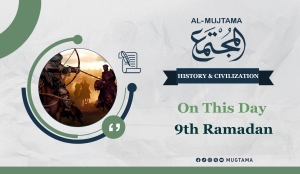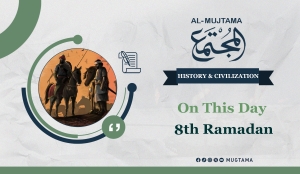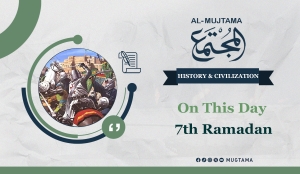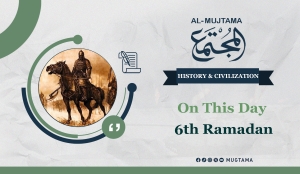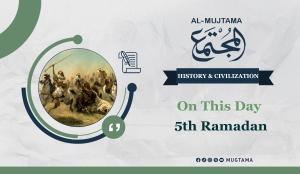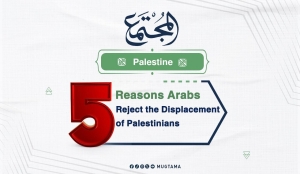Nada Gamal
On this Day… 12th of Ramadan
March 12, 2025On this Day… 12th of Ramadan
The Muslim Army Enters Andalusia On the 12th of Ramadan in the year 92 AH (711 CE),
The Birth of Muhammad ibn Qasim On the 12th of Ramadan in the year 72 AH (692 CE),
The Battle of Hattin Preparations On the 12th of Ramadan in the year 583 AH (1187 CE),
----
The Muslim Army Enters Andalusia
On the 12th of Ramadan in the year 92 AH (711 CE), Tariq ibn Ziyad and his Muslim army entered the Iberian Peninsula (Andalusia) to begin the conquest of Spain. This marked the beginning of the spread of Islam in Western Europe.
The Birth of Muhammad ibn Qasim
On the 12th of Ramadan in the year 72 AH (692 CE), Muhammad ibn Qasim, the famous Muslim general who led the conquest of Sindh (modern-day Pakistan), was born. He is celebrated for his significant role in spreading Islam in the Indian subcontinent.
The Battle of Hattin Preparations
On the 12th of Ramadan in the year 583 AH (1187 CE), Salah al-Din al-Ayyubi (Saladin) began his preparations for the Battle of Hattin, which would eventually lead to the Muslim recapture of Jerusalem from the Crusaders.
On this day… 11th of Ramadan
March 11, 2025On this day… 11th of Ramadan
- Year 3 of Hijra (624 CE): The Marriage of the Prophet Muhammad (PBUH) to Zainab bint Khuzayma
- Year 9 of Hijra (630 CE): the arrival of the Thaqif Delegation
- Year 624 AH (25 August 1227 CE): the Death of Genghis Khan
- Year 922 AH (1516 CE): The Entry of Sultan Selim I into Damascus
- Year 95 AH, (714 CE): The Martyrdom of Sa'id ibn Jubayr
- The Marriage of the Prophet Muhammad (PBUH) to Zainab bint Khuzayma
In the 3rd year of Hijra, the Prophet Muhammad (PBUH) married Zainab bint Khuzayma, who was known as "Umm al-Masakin" (Mother of the Poor) due to her generosity and care for the needy.
- The Arrival of the Thaqif Delegation In the 9th year of Hijra
A delegation from the Thaqif tribe came to the Prophet Muhammad (PBUH) and embraced Islam. This delegation was composed of six prominent members of the tribe.
- The Death of Genghis Khan On the 11th of Ramadan in the year 624 AH (25 August 1227 CE)
Genghis Khan, the founder of the Mongol Empire, passed away. He was buried in Mongolia, and his son Ogedei succeeded him as the ruler of the empire.
- The Entry of Sultan Selim I into Damascus
In the year 922 AH (1516 CE), Sultan Selim I of the Ottoman Empire entered the city of Damascus. This event marked the beginning of Ottoman control over the region, following their victory over the Mamluks.
- The Martyrdom of Sa'id ibn Jubayr
Sa'id ibn Jubayr was martyred on the 11th of Ramadan in the year 95 AH, which corresponds to 714 CE
Book Review (Assassination of the Palestinian Environment)
March 10, 2025The Israeli occupation authorities have systematically and deliberately worked to destroy the Palestinian environment. The occupation has manifested in the confiscation of all aspects of Palestinian life, aimed at eliminating all its components and forcing Palestinians to leave on their own when the conditions for life cease to exist. Despite the dismal Zionist bet on the departure of Palestinians, they have astonished the world with their steadfastness and attachment to the land of their ancestors, despite the dwindling and even complete lack of resources for life in many villages and towns, especially those that have become isolated from their Palestinian surroundings due to the walls of annexation and apartheid.
The book "Assassination of the Palestinian Environment: Ethnic Cleansing," authored by Mustafa Saad El-Din Qaoud, addresses the relationship between occupation and the Palestinian environment, focusing on how Zionist policies have impacted the destruction of the Palestinian environment as part of the ongoing ethnic cleansing project against the Palestinian people.
The main summary of the book:
- Ethnic cleansing and environmental destruction:
The book links environmental destruction to the ethnic cleansing carried out by the "Israeli" occupation. It indicates that the destruction of the environment is part of a strategy to displace Palestinians from their lands and eliminate their presence in the occupied territories.
- Destruction of natural resources:
The book discusses how the occupation has targeted Palestinian natural resources such as agricultural land, water, and forests, as well as military barriers that hinder mobility and prevent Palestinians from accessing their resources.
- Settlement and Zionist Expansion:
The book explains that settlement is one of the most prominent causes of the destruction of the Palestinian environment, as the establishment of settlements on Palestinian land has led to the destruction of agricultural and natural ecological systems.
- Effects of Occupation on the Environment:
The book discusses the negative effects of occupation on the environment through pollution and the extraction of natural resources such as groundwater, which have come under the control of the occupation at the expense of the Palestinians.
- Strategies of Palestinian Resistance
In the end, the book highlights the methods of Palestinian resistance aimed at protecting the environment and countering the practices of occupation that target Palestinian land and resources.
The book presents a comprehensive picture of how the occupation utilizes the environment as a tool in the process of ethnic cleansing, and calls for the necessity of focusing on defending the Palestinian environment as part of the overall resistance against the occupation.
On This Day...10th Ramadan
March 10, 2025- The Killing of Minister Nizam al-Mulk by the Assassins (485 AH)
- Ramadan War (1393 AH / 1973 AD)
- Defeat of the Crusaders in Mansoura and the Capture of King Louis IX (648 AH)
The Killing of Minister Nizam al-Mulk by the Assassins (485 AH)
The Assassination
In 485 AH, one of the boys of the Al-Batiniya Squad, known as the Assassins, managed to kill Nizam al-Mulk Abu al-Hassan Ali bin Ishaq. He was a minister to Sultan Alp Arslan and then a minister to his son Malakshah for about thirty years. The assassin fatally stabbed him, and he fell dead2.
Ramadan War (1393 AH / 1973 AD)
The War Begins
In 1393 AH, the Tenth of Ramadan War began. Egypt and Syria fought against the Zionist entity to recover the lands that were occupied in the 1967 setback5.
Defeat of the Crusaders in Mansoura and the Capture of King Louis IX (648 AH)
The Battle
On 10 Ramadan 648 AH / 12 December 1250 AD, the Muslims defeated the Crusaders in the Battle of Mansoura, where King Louis IX was captured. A large number of Louis IX's soldiers were killed and captured8.
The Forces
The Battle of Mansoura took place between the French Crusader forces led by Saint Louis IX, King of France, and the Egyptian Ayyubid forces led by Prince Fakhr al-Din Yusuf bin Sheikh al-Shuyukh. The Egyptian army was led during the reign of the righteous King Najm al-Din Ayyub, Fakhr al-Din Yusuf bin Sheikh al-Shuyukh, Faris al-Din Aktay, the leader of the Bahri Mamluks and the commander of the Battle of Mansoura, and Rukn al-Din al-Zahir Baybars.
The Outcome
The battle resulted in a major defeat of the Seventh Crusade, and after that, a new campaign was not sent to occupy Egypt. The defeats of the Crusaders began to continue after the Battle of Mansoura, until the Levant was completely liberated later from the Crusaders.
On This Day... 9th Ramadan
March 09, 2025- The Conquest of Sicily in 212 AH
- Musa bin Naseer Completed the Conquest of Andalusia (93 AH)
- Battle of Zalaca (479 AH)
The Conquest of Sicily in 212 AH
The Conquest
Sicily was conquered by the commander Asad bin Al-Furat bin Sinan during the reign of Caliph Al-Ma'mun on the 9th of Ramadan 212 AH. Asad bin Al-Furat, may God have mercy on him, was a scholar, a knight, a brave and courageous hero.
The Battle
The owner of Sicily marched to him with a hundred and fifty thousand men. A man said: I saw a lion with a banner in his hand reading Surah Ya-Sin, then he charged with the army and defeated the enemy. I saw blood flowing down the channel of the flag and on his arm, and he fell ill while he was besieging Syracuse.
Musa bin Naseer Completed the Conquest of Andalusia (93 AH)
The Campaign
In 93 AH, June 18, 712 AD, Commander Musa bin Naseer undertook a campaign to complete the conquest of Andalusia. He completed the conquest of Seville and Toledo.
Battle of Zalaca (479 AH)
The Battle
In the year 479 AH, corresponding to December 17, 1086 AD, Youssef bin Tashfin, commander of the Almoravid armies, defeated the Franks, led by Alfonso VI, in the Battle of Zalaca. Alfonso escaped with only nine members of his army.
Historical Context
Some sources indicate that the Battle of Zalaca took place on Friday, 12 Rajab 479 AH, October 23, 1086, CE.
On This Day... 8th Ramadan
March 08, 2025- Alparslan Assumed Power (455 AH)
- Al-Zahir Baybars Siege of Acre City (665 AH)
Alparslan Assumed Power (455 AH)
Assumption of Power
Alparslan assumed power after the death of his uncle Tughrul Bey on Ramadan 8, 455 AH / September 4, 1063 AD. There had been some disputes about assuming power in the country, but Alp Arslan was able to overcome them.
Leadership and Policies
Alp Arslan, like his uncle Tughrul Bey, was a skillful and daring leader. He adopted a special policy that relied on consolidating the pillars of his rule in the countries under the influence of the Seljuks before looking to subjugate new territories and annex them to his state. He was also eager to wage jihad for the sake of God and to spread the call of Islam within the neighboring countries, such as the countries of the Armenians and the countries of the Romans.
Conquests and Jihad
The spirit of Islamic jihad was the driving force behind the conquests carried out by Alp Arslan, which gave them a religious character. The leader of the Seljuks, Alp Arslan, became a leader in the defense of Muslims, keen to support Islam and spread it in those lands. He raised the flag of Islam flying over many areas of the lands of the Byzantine state.
Battle of Manzikert
Sultan Alp Arslan (the Lion-Hearted), who opened the gates of Anatolia to Turks in 1071 by defeating the Byzantine army, is remembered for his heroism and war strategies. His victory on Aug. 26, 1071, on the plain of Manzikert (Malazgirt), accelerated the decline of the Byzantine Empire and led to more Turks settling in the region, paving the way for both the Ottoman Empire and the modern Republic of Turkey.
Educational and Cultural Renaissance
Sultan Alp Arslan would not have achieved all these achievements without the efforts of his great vizier Nizam al-Mulk, who was not only a brilliant vizier and a skilled politician but also a preacher of science and literature. He established schools known as the “Nizamiyya Schools,” paid them salaries, and attracted senior jurists and hadith scholars to them, led by Hujjat al-Islam “Abu Hamid al-Ghazali.”
Legacy and Death
The status of Alp Arslan rose after his brilliant victory, and he became feared in the Islamic East and the Christian West. However, Sultan Alp Arslan did not enjoy much of what he achieved and continued his conquests. He was killed a year and a half after the Battle of Manzikert at the hands of one of the rebels against him, when he was forty-four years old, on (10 Rabi` al-Awwal 465 AH = November 29, 1072 AD). He was succeeded by his son Malikshah, who had military and cultural achievements in the fifth century AH.
Al-Zahir Baybars Siege of Acre (665 AH)
The Siege Begins
On the 8th of Ramadan in the year 665 AH / 1267 AD, the siege of the city of Acre began under the leadership of Al-Zahir Baybars. He was informed that while he was in Damascus, a group of Franks attacked Muslims at night and hid while wearing Muslim clothes.
Baybars' Response
Sultan Baybars led a special detachment that managed to seize them after they were setting off from Acre. The Franks residing in Acre tried to strike the Muslims, so Baybars ordered the elimination of its garrison and the demolition of its walls if its people did not comply with loyalty to the Islamic system of the state.
On this Day... 7th Ramadan
March 07, 2025- The Launching of Al-Azhar Mosque
- Turgut Reis Liberates 7 thousand Muslim Prisoners
The Launching of Al-Azhar Mosque
Inauguration
On Ramadan 7, 361 AH - June 26, 972 AD, the Al-Azhar Mosque was inaugurated, and the first prayer was held in it. The muezzin's voice emitted from the minaret of Al-Azhar Mosque in Cairo, Egypt. Al-Azhar has a scientific and religious status among all Muslims in the east and west of the earth.
Foundation and Name
It was created by Jawhar al-Siqilli during the reign of the Obaidi ruler al-Muizz Li Din Allah. There is a difference of opinion regarding why it was so called, but it is more likely that it was named after Fatima Al-Zahraa, may Allah be pleased with her.
Purpose and Transformation
The initial goal of the Obeidis in building Al-Azhar Mosque was to spread the Shiite sect in Egypt. However, Egypt returned to the Sunni sect during the reign of Salah al-Din al-Ayyubi, and Al-Azhar has since been one of the largest beacons of the Sunni sect all over the world.
Turgut Reis Liberates 7 thousand Muslim Prisoners
The Liberation Campaign
On the 7th of Ramadan, August 17th of the year 1553 AD, the Ottoman naval commander, Turgut Reis, seized the island of Corsica and the city of Catania in Sicily. After exterminating its garrison, he freed seven thousand Muslim prisoners.
Handing Over Corsica
Turgut Reis then handed over Corsica to the French. However, the French could not keep it for long against the Spaniards, who controlled the island in the same year.
On This Day 6th Ramadan
March 06, 2025- An Attempt to Assassinate the Emir of Kuwait (6 Ramadan 1405 AH)
- Conquest of Sindh (6 Ramadan 63 AH)
An Attempt to Assassinate the Emir of Kuwait (6 Ramadan 1405 AH)
The Attack
On the sixth of Ramadan 1405 AH / May 25, 1985, at exactly nine-quarters of that morning, the convoy of the Emir of the State of Kuwait, Sheikh Jaber Al-Ahmad Al-Sabah - may God have mercy on him - was attacked by a car bomb. While he was on his way to his office in the Seif Palace, a car parked at the middle sidewalk of the road tried to break into his convoy. This led to its explosion, including explosive materials, and the burning of a number of convoy cars and other nearby cars.
Casualties
The accident resulted in the death of three martyrs. Two of them were from the Emir's bodyguards, and the third was a passer-by, in addition to the perpetrator. As a result of the explosion, a large number of people were injured, including 12 passers-by.
Conquest of Sindh (6 Ramadan 63 AH)
The Battle
On the 6th of Ramadan 63 AH, May 14, 682 AD, Muhammad bin Al-Qasim defeated the armies of India at the Indus River, and the country of Sindh was conquered. This was at the end of the era of Al-Walid bin Abdul-Malik.
The Caliphate's Orders
When Al-Walid bin Abd al-Malik succeeded to the caliphate, al-Hajjaj bin Yusuf al-Thaqafi entrusted Muhammad bin al-Qasim with the invasion of India. He marched to it in the year 98 AH, besieged the Dibel gap, forcibly opened it, and built a mosque there.
Continued Conquests
Muhammad bin Al-Qasim continued his conquests in this country, until he reached the Indus River and met Dahir, the king of Sindh. Daher and his army fought fiercely on the backs of elephants, which ended with the killing of Daher and the defeat of his companions.
Thus, Muhammad bin Al-Qasim was able to extend his conquests throughout the entire country of Sindh.
On This Day 5th Ramadan
March 05, 2025- Lydda Massacre (5th Ramadan 1367)
- Battle of Bir al-Ghabi, Libya (5th Ramadan 1342 AH)
Lydda Massacre (5th Ramadan 1367)
On 5th Ramadan 1367 AH, July 11, 1948, to relieve the besieged city of Jerusalem from military pressure, Zionist forces launched a large-scale military operation. Known as Operation Dani, it aimed to occupy the cities of Lydda and Ramla.
The Defense of Lydda
Despite their limited capabilities, Lydda's defenders showed great resistance. Yet, two days later, Zionists succeeded in occupying the city. On the third day, they perpetrated a brutal massacre against its Arab residents.
The Massacre
Although some residents sought refuge in the Dahmash Mosque, Zionists didn't spare them. More than 400 Arabs were killed, and the survivors were forced to seek refuge outside their city.
Battle of Bir al-Ghabi, Libya (5th Ramadan 1342 AH)
This battle is considered one of the most important battles of the Libyan jihad against the Italian occupation. The Italians were following the movements of the Mujahideen Sheikh Omar al-Mukhtar and were waiting for the first opportunity to eliminate him and extinguish the struggle launched by him and his companions the mujahideen against the occupation.
The Ambush
During his return from Egypt and his crossing of the Libyan border, seven Italian armored cars ambushed him in one of the villages of Bir al-Ghabi - about 80 kilometers south of Tobruk. The Mujahideen clashed with them and shot them, and that was on April 23, 1923, 5th Ramadan 1342 AH.
The Battle
The Italian forces retreated a little to a nearby resort, then returned quickly, and were distributed tightly. The soldiers began to come down and put the wools in front of them to protect them from bullets. All the attacking Italians, with the exception of one armored vehicle, managed to escape, while three of the Mujahideen were martyred.
5 Reasons Arabs Reject the Displacement of Palestinians
March 05, 2025
In light of the ongoing Israeli occupation and its attempts to alter the demographic reality in Palestine, the Arab refusal to displace Palestinians emerges as a central issue that reflects a commitment to the historical and humanitarian rights of this people. This rejection is not only rooted in national and historical dimensions but is also based on legal and ethical foundations that reinforce the right of Palestinians to remain in their land and to return to it.
In this context, we present five main reasons that drive Arabs to reject any attempts to uproot Palestinians from their homeland:
- the right to return:
The Arabs reject the displacement of Palestinians because they believe that Palestinians have the right to return to their lands from which they were displaced following the Nakba of 1948. They believe that this right is part of humanitarian justice and the fundamental rights that peoples should enjoy.
- National Identity.
The issue of the displacement of Palestinians contradicts the preservation of Palestinian national identity, and Arabs believe that the Palestinian people have a long history and culture that is deeply rooted in their land. Their displacement reinforces the occupying state's attempts to obliterate this identity.
- Recognition of Palestinian rights:
The Arab rejection reflects a refusal to the attempts of the occupying state to cancel or manipulate the rights of Palestinians, including the right to establish an independent state on their lands. They emphasize that the displacement of Palestinians constitutes a violation of fundamental rights and leads to deepening injustice against them.
- Arab solidarity:
The Palestinian people are not alone in their plight, and the Arab world feels a responsibility towards the Palestinians as part of the Arab nation. Arab support for the Palestinian cause reflects this solidarity.
- International Law:
The expulsion of Palestinians contradicts the fundamental principles of international law, especially the United Nations Charter, which emphasizes the right of peoples to self-determination. Therefore, Arabs condemn any attempts to evict them or uproot them from their lands.





